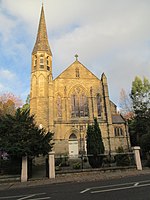Limefield
1830 establishments in EnglandCheshire building and structure stubsCountry houses in CheshireGrade II listed buildings in CheshireGrade II listed houses ... and 2 more
Houses completed in 1830United Kingdom listed building stubs
Limefield is a house standing to the north of Bollington, Cheshire, England. It was built in about 1830 for Joseph Brook. It is constructed in ashlar brown sandstone, and has a pyramidal roof of Welsh slate with a large stone central chimney. Its plan is square, with an extension to the rear. The house has two storeys, with a symmetrical three-bay front. It is recorded in the National Heritage List for England as a designated Grade II listed building. Its stables and coach house are also listed at Grade II.
Excerpt from the Wikipedia article Limefield (License: CC BY-SA 3.0, Authors).Limefield
Long Lane,
Geographical coordinates (GPS) Address Nearby Places Show on map
Geographical coordinates (GPS)
| Latitude | Longitude |
|---|---|
| N 53.30017 ° | E -2.09715 ° |
Address
Long Lane
Long Lane
SK10 5LE , Bollington Cross
England, United Kingdom
Open on Google Maps








